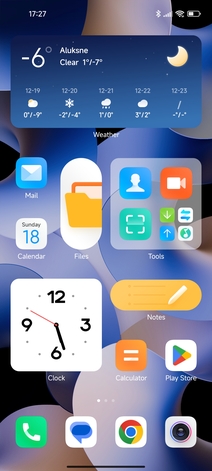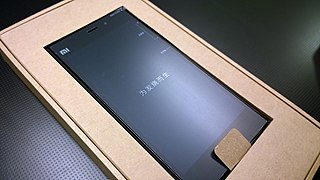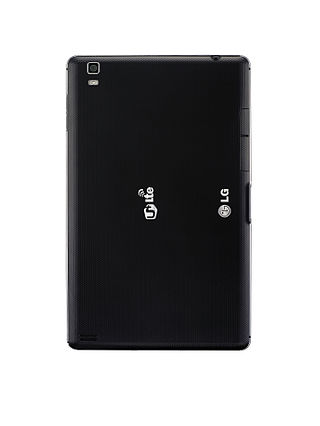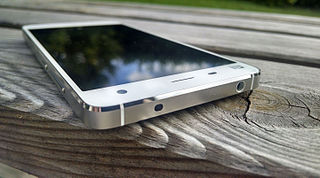
Tegra is a system on a chip (SoC) series developed by Nvidia for mobile devices such as smartphones, personal digital assistants, and mobile Internet devices. The Tegra integrates an ARM architecture central processing unit (CPU), graphics processing unit (GPU), northbridge, southbridge, and memory controller onto one package. Early Tegra SoCs are designed as efficient multimedia processors. The Tegra-line evolved to emphasize performance for gaming and machine learning applications without sacrificing power efficiency, before taking a drastic shift in direction towards platforms that provide vehicular automation with the applied "Nvidia Drive" brand name on reference boards and its semiconductors; and with the "Nvidia Jetson" brand name for boards adequate for AI applications within e.g. robots or drones, and for various smart high level automation purposes.
Project Denver is the codename of a central processing unit designed by Nvidia that implements the ARMv8-A 64/32-bit instruction sets using a combination of simple hardware decoder and software-based binary translation where "Denver's binary translation layer runs in software, at a lower level than the operating system, and stores commonly accessed, already optimized code sequences in a 128 MB cache stored in main memory". Denver is a very wide in-order superscalar pipeline. Its design makes it suitable for integration with other SIPs cores into one die constituting a system on a chip (SoC).

The Asus Eee Pad Transformer TF101 is a 2-in-1 detachable tablet developed by Asus that runs the Android operating system. It is the first tablet in the Asus Transformer Pad series. The Eee Pad Transformer features a 10.1-inch (260 mm) display, an Nvidia Tegra 2 dual-core chip, 1 GB of RAM, and 16 or 32 GB of storage. The tablet initially launched with Android 3.1, nicknamed "Honeycomb", but was updated to support Android 4.0.3.

MIUI is a discontinued mobile operating system developed and maintained by manufacturer Xiaomi exclusively for its smartphones and related communication devices. MIUI is based on the Android Open Source Project (AOSP) version of Android, and serves as the basis for other operating systems created by Xiaomi: MIUI for POCO, MIUI Pad, MIUI Watch, and MIUI TV (PatchWall).
EVGA Corporation is an American computer hardware company that produces motherboards, gaming laptops, power supplies, all-in-one liquid coolers, computer cases, and gaming mice. Founded on April 13, 1999, its headquarters are in Brea, California. EVGA also produced Nvidia GPU-based video cards until 2022.

Xiaomi Corporation, commonly known as Xiaomi and registered as Xiaomi Inc., is a Chinese designer and manufacturer of consumer electronics and related software, home appliances, automobiles and household hardware. It is the second-largest manufacturer of smartphones in the world, behind Samsung, most of which run on the MIUI operating system, which is based on the Android operating system. The company is ranked 338th and is the youngest company on the Fortune Global 500.
The IdeaPad tablets from Lenovo were a brand of consumer-oriented tablet computers designed for home use or entertainment, as opposed to the business-focused ThinkPad Tablet series. Devices sold in certain countries, such as China, India and New Zealand, were sold under the LePad brand, similar to the LePhone series of smartphones. IdeaPad-branded tablets have been produced with the Android and Windows operating systems.

The Nvidia Shield Portable is a handheld game console developed by Nvidia, released on July 31, 2013. The console runs on Android Lollipop 5.1, featuring a flip 130mm (5-inch) touchscreen display with 1280×720 resolution. The device is similar in shape to an Xbox 360 controller and similar in control setup to a DualShock controller, with two analog joysticks, a D-pad, and other buttons. It is the first device to use Nvidia's Tegra 4 processor. It was originally called Shield or Nvidia Shield, but since the launch of the Shield Tablet, it is called the Shield Portable. Due to being out of stock for many years, it is thought to be discontinued, but there has not yet been any official announcement from Nvidia.

The Xiaomi Mi 3 is a high-end, premium Android smartphone produced by Xiaomi made in the Philippines.

The LG Optimus Pad LTE is a tablet computer developed by LG Electronics as a direct successor to the original LG Optimus Pad released in South Korea in January 2012. The LG Optimus Pad LTE was planned to be released worldwide but was cancelled due to its lackluster sales in its domestic market and mixed-to-negative reception towards the device leaving LG to withdraw in the tablet making for a brief period in the world market before the release of its successor the LG G Pad 8.3.
The Tegra Note 7 is a mini tablet computer and the second Tegra 4 based mobile device designed by Nvidia that runs the Android operating system.

The Xiaomi Mi 4 is a smartphone developed by the Chinese electronics manufacturer Xiaomi for its high-end smartphone line, and was released in August 2014. Xiaomi held an event to formally introduce the high-end phone, and its complementary smart-accessory, the Xiaomi MiBand, during the Xiaomi New Product Launch Event 2014 on 22 July 2014.

The Shield Tablet, later relaunched as the Shield Tablet K1, is a gaming tablet, developed by Nvidia and released on July 29, 2014. It was Nvidia's second portable gaming device that uses Android. Compared to the Shield Portable, the controller is not permanently connected to the screen, rather it can be purchased separately. Up to four controllers can be wirelessly connected at the same time. While the Shield tablet features an 8-inch 1920×1200 pixel display, it can output 4K resolution signal to a television via HDMI.

Redmi is a subsidiary company owned by the Chinese electronics company Xiaomi. It was first announced in July 2013 as a budget smartphone line, and became a separate sub-brand of Xiaomi in 2019 with entry-level and mid-range devices, while Xiaomi itself produces upper-range and flagship Xiaomi phones. Redmi phones use Xiaomi's MIUI user interface on top of Android. Models are divided into the entry-level Redmi, the mid-range Redmi Note, and the high-end Redmi K. The unrelated Mi A Android One series is positioned in the same market segment as Redmi devices, despite being part of the upper-range Xiaomi Mi lineup. The most significant difference from other Xiaomi smartphones is that Redmi uses less expensive components, allowing lower prices while retaining good specifications. In August 2014, The Wall Street Journal reported that in the second quarter of the 2014 fiscal year, Xiaomi had a market share of 14% of the China smartphone market; Redmi sales were attributed as a contributing factor toward this ranking.

The Nokia N1 is an Android-powered tablet developed by Nokia. Unveiled on 18 November 2014, it is Nokia's first mobile device since the sale of its original mobile phone business to Microsoft earlier in the year. It was released in China on 7 January 2015.
The Xiaomi Mi4i is a smartphone developed by Xiaomi Inc. It is part of Xiaomi's mid-range smartphone line, and was released in April 2015. Xiaomi held a media event in Siri Fort Auditorium, Delhi to formally introduce the mid-range phone, and also supplied its fans with their complementary smart-accessory, the Xiaomi MiBand, during the Xiaomi New Product Launch Event 2015 on April 23, 2015.

The Xiaomi Redmi Note 4 is the fourth smartphone under the Redmi Note series developed by Xiaomi Inc. It is a part of Xiaomi's budget Redmi smartphone lineup. It has two variants : The older version sold as Redmi Note 4 is powered by a Deca-core Mediatek MT6797 Helio X20 SOC. The upgraded version, sold both as Redmi Note 4X and Redmi Note 4 is powered by an Octa-core MSM8953 Qualcomm Snapdragon 625 SoC. The Redmi Note 4 was succeeded by Redmi Note 5.

The Xiaomi Mi A1, is a smartphone co-developed by Google, as part of its Android One initiative — and Xiaomi that runs on the Android operating system.

Xiaomi Redmi Note 5 is a smartphone developed by Xiaomi Inc. It is a part of Xiaomi's budget Redmi Note smartphone line. Redmi Note 5 was announced on 14 February 2018 in Delhi, India, alongside the local release of the Redmi Note 5 Pro.














